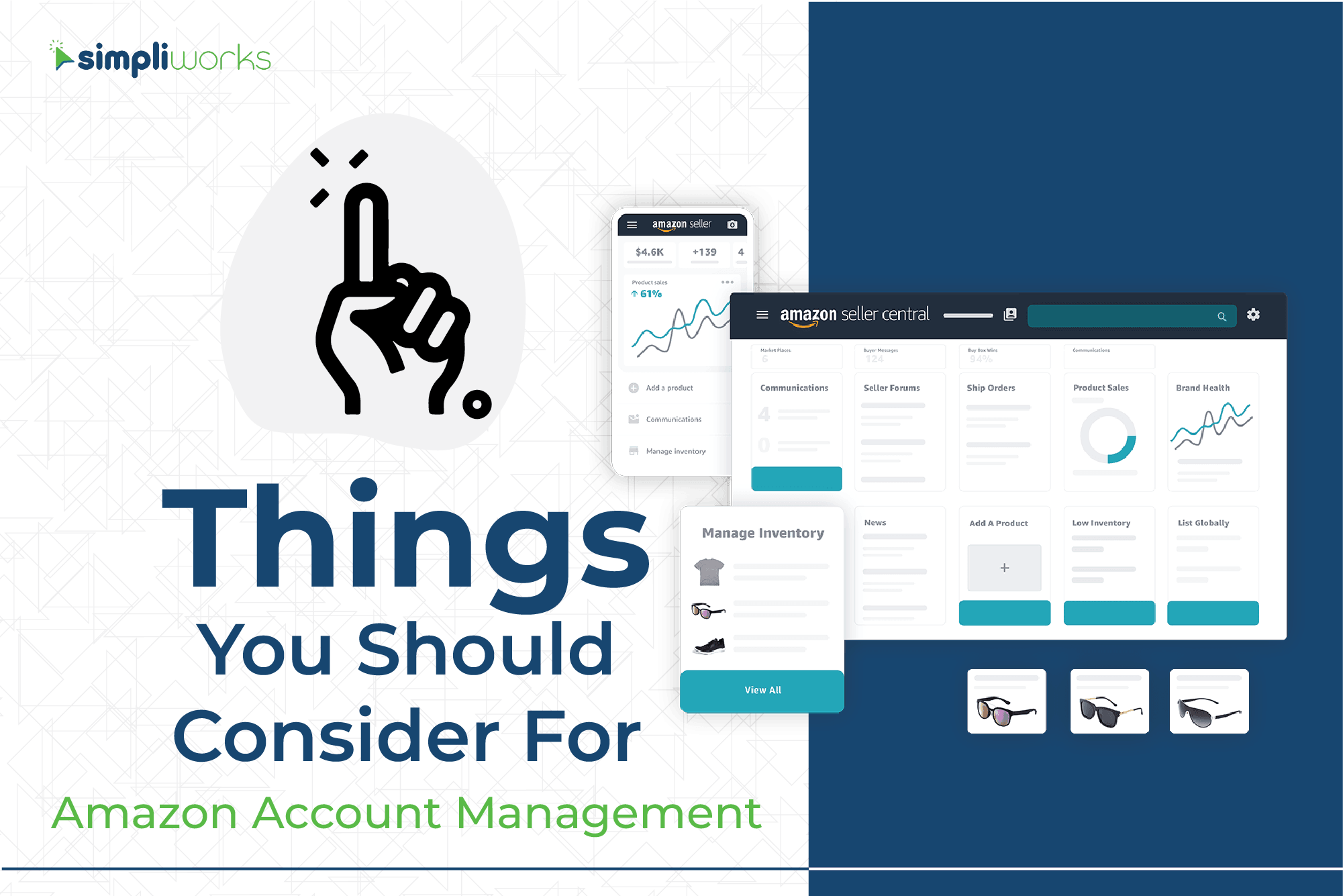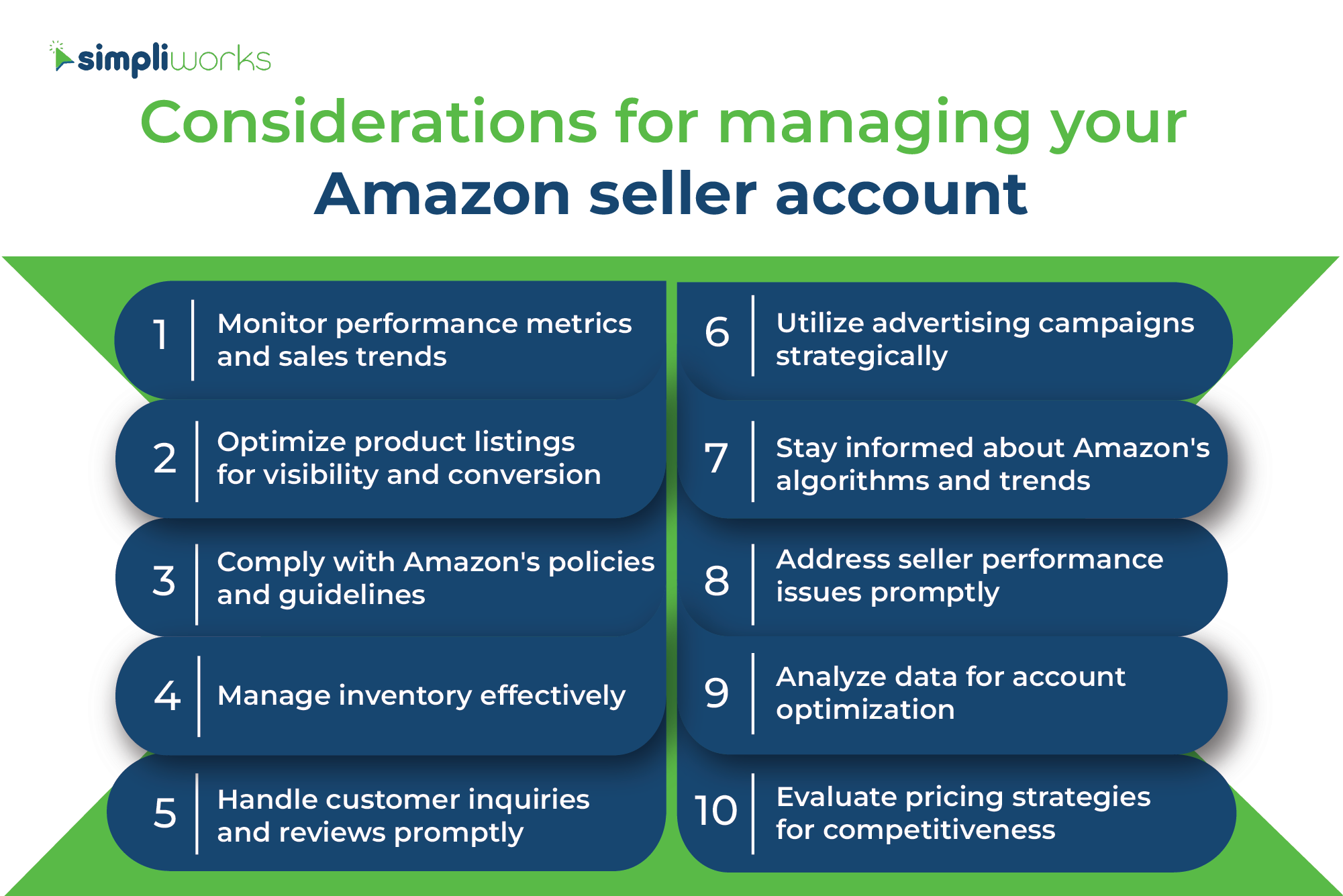In the fast-paced world of e-commerce, standing out on platforms like Amazon is crucial for...
10 Proven Steps for Profitable Amazon Account Management

Managing your Amazon seller account effectively is crucial for success in the highly competitive online marketplace. With millions of sellers vying for customers' attention, optimizing your account to increase visibility, drive sales, and maintain a positive reputation is essential. In this blog post, we'll discuss ten critical considerations for effective Amazon account management.
What things should you consider while managing your Amazon seller account?
1. Monitor performance metrics and sales trends regularly
Keeping a close eye on your performance metrics is vital for understanding the health of your Amazon account. Metrics such as Order Defect Rate (ODR), Late Shipment Rate (LSR), and Customer Feedback can directly impact your account's performance and Buy Box eligibility. Regularly monitoring sales trends helps identify patterns, enabling you to make data-driven decisions to boost your revenue.
2. Optimize product listings for better visibility and conversion
Investing time in optimizing product listings is crucial for improving visibility and driving conversions. Focus on writing compelling product titles, detailed and accurate descriptions, and high-quality images. Incorporate relevant keywords and use bullet points to highlight key features. Consider leveraging Enhanced Brand Content (EBC) or A+ Content to enhance your listings further.
3. Stay compliant with Amazon's policies and guidelines
Adhering to Amazon's policies and guidelines is essential to avoid penalties or suspension. Familiarize yourself with the rules regarding product authenticity, prohibited content, pricing, and customer communication. Regularly review the Seller Central forums and policy updates to stay informed about any changes.
Read our latest blog: Why Should You Hire an Amazon Account Management Company?
4. Manage inventory effectively to avoid stockouts or overstocking
Maintaining an optimal inventory level is crucial to meet customer demand while avoiding stockouts or excess inventory. Leverage tools like Amazon's Inventory Performance Index (IPI) to optimize your inventory management. Utilize forecasting techniques and monitor sales velocity to make informed decisions regarding restocking.
5. Handle customer inquiries and reviews professionally
Timely and professional customer support is key to maintaining a positive reputation on Amazon. Respond promptly to customer inquiries, address concerns, and courteously resolve issues. Encourage satisfied customers to leave reviews, and promptly address any negative reviews by offering solutions or explanations.
6. Utilize advertising campaigns strategically for maximum impact
Advertising campaigns can significantly boost your product's visibility and sales. Consider using Sponsored Products, Sponsored Brands, and Display Ads strategically. Regularly analyze campaign performance, adjust bidding strategies, and optimize keyword targeting to maximize your return on ad spend.

7. Stay informed about changes in Amazon's algorithms and marketplace trends
Amazon's algorithms and marketplace trends are constantly evolving. Stay updated with the latest changes through resources like the Amazon Seller blog, newsletters, and industry forums. Understanding these changes will help you adapt your strategies and stay ahead of the competition.
8. Monitor and address seller performance issues promptly
Maintaining a high seller performance is crucial for account health. Keep a close eye on your performance metrics and promptly address any issues. Actively work to improve your performance to ensure continued eligibility for programs like Amazon Prime and eligibility for the Buy Box.
Also Read: Amazon Listing Optimization 101 (With Free Checklist for Sellers)
9. Analyze data and make data-driven decisions for account optimization
Utilize data analytics tools to gain insights into your sales, customer behavior, and advertising campaigns. Analyze the data to identify patterns, trends, and areas for improvement. Make informed decisions based on the data to optimize your account's performance.
10. Continuously evaluate pricing strategies for competitiveness and profitability
Regularly assess your pricing strategies to ensure competitiveness in the marketplace while maintaining profitability. Consider factors like production costs, competitor pricing, and customer demand. Adjust your prices as needed to strike the right balance.

How Does Account Management Work?
Effective account management involves a multi-faceted approach, combining strategy, data analysis, and ongoing optimization. It requires a deep understanding of Amazon's platform, policies, and marketplace dynamics. By proactively monitoring metrics, optimizing listings, providing excellent customer service, and leveraging advertising campaigns strategically, you can position your account for success.
Why Hire a Team to Manage Your Amazon Seller Account?
Managing an Amazon seller account requires time, expertise, and attention to detail. Hiring a professional team specializing in Amazon account management can alleviate the burden, allowing you to focus on other aspects of your business. An experienced team can stay abreast of changes, implement best practices, and leverage their expertise to optimize your account and drive growth.
Final Thoughts
Effective Amazon account management is a continuous process that requires attention to detail, data analysis, and strategic decision-making. Considering the ten key aspects discussed in this blog post and staying proactive in managing your account, you can maximize your success on Amazon's platform. Remember, ongoing optimization and adaptation to marketplace changes are essential to thrive in the competitive e-commerce landscape.




